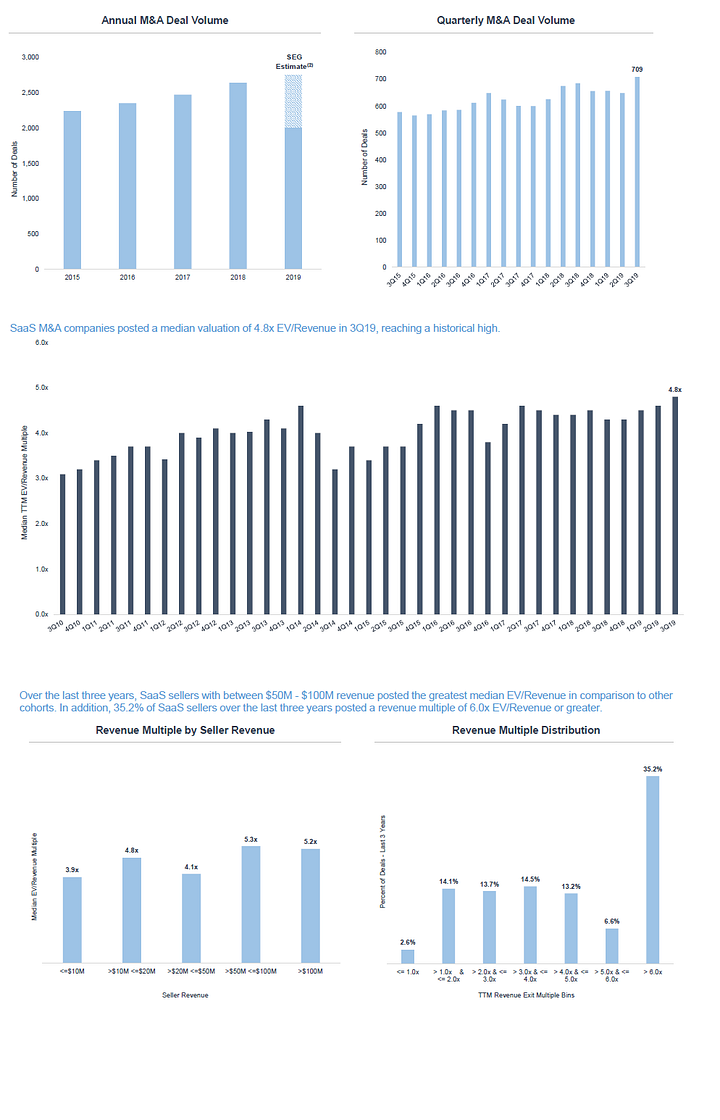The SaaS M&A Report – Q3
We recently got Software Equity Group’s SaaS M&A Snapshot for Q3 2019. SEG is an investment bank focused SaaS companies and they put out fantastic data on what they’re seeing in the market. Key observations from their latest report are as follows:

Deal volume is still high. There were 314 M&A transactions in SaaS in Q1, an all time high. Q2 was strong, but materially lower 277 transactions. SEG expects this year to be another record for deal volume.
Multiples are good. The median revenue multiple was 4.8x in Q2, up from 4.6x last quarter. The median has remained above 4x for 13 out of the past 15 quarters (in Q4 2016 it dipped to 3.8x). The 9 year median and average since Q2 2010 is 4.0x. About 1/3rd of companies sold for greater than 6.0x revenue, but those companies tend to have higher ARR ($50mm+).
Size drives multiples. Valuation is largely driven by company size. Organizations exhibiting scale are generally rewarded with higher multiples. Over the past 3 years, companies with revenue between $50mm to $100mm posted the highest median multiple (5.3x EV/Revenue).
In M&A, companies are often valued based on LTM revenue (last twelve months), not annualized recurring revenue or even forward revenue. SEG tries to push acquirers to apply multiples to these higher revenue figures, but it’s atypical. Depending on how fast you’re growing, there could be a big difference in value between 5x LTM revenue and 5x ARR.
Private equity. Private equity buyers represent half of buyers (57%) which means they’re paying higher premiums than strategics; you shouldn’t only reach out to strategics when you go to sell.
Growth. In order to earn a premium multiple, strive for maintaining at least 40% year over year growth with at least 90% of that revenue coming from contracted recurring streams.
Profitability. If you’re growing under 40% per year or even slower, strive for a 30%+ EBITDA margin. If you’re not profitable, growth needs to be well in excess of 40% to offset, or you’ve got to be able to make a case that you could be profitable if you wanted to be, but you’re re-investing cash in sales and marketing burning cash in order to spike growth.
Qualitative Factors. Non-financial factors such as the age of the tech, strength of the team, and the uniqueness of the product all come into play. If your product is good enough, many acquirers will overlook major shortcomings on the financial side.
M&A is Unpredictable. M&A can take anywhere from 2 months to 2 years depending on what type of process is run (abbreviated versus full) and what the interest level is for your company. When an acquirer solicits you and you say ‘no’, that acquirer doesn’t just wait around for you to decide to sell. They either build your tech themselves or they acquire a competitor, even if that competitor isn’t as good as you. Once either of those two things happens, consider that acquirer gone in the future. We’ve seen this happen first hand when Yahoo tried to acquire one of our portfolio companies. We said ‘no’ believing we could get a higher price later. Then when we were ready to sell 2 years later, Yahoo was gone as a potential acquirer as they went out and bought some of our smaller competitors.
Hiring a great banker is critical to maximizing value in an M&A process, and banks like Software Equity Group are who you should look to.
Visit us at blossomstreetventures.com. Email Sammy at especially if you have a Series A or B opportunity we should look at. We welcome cold emails.